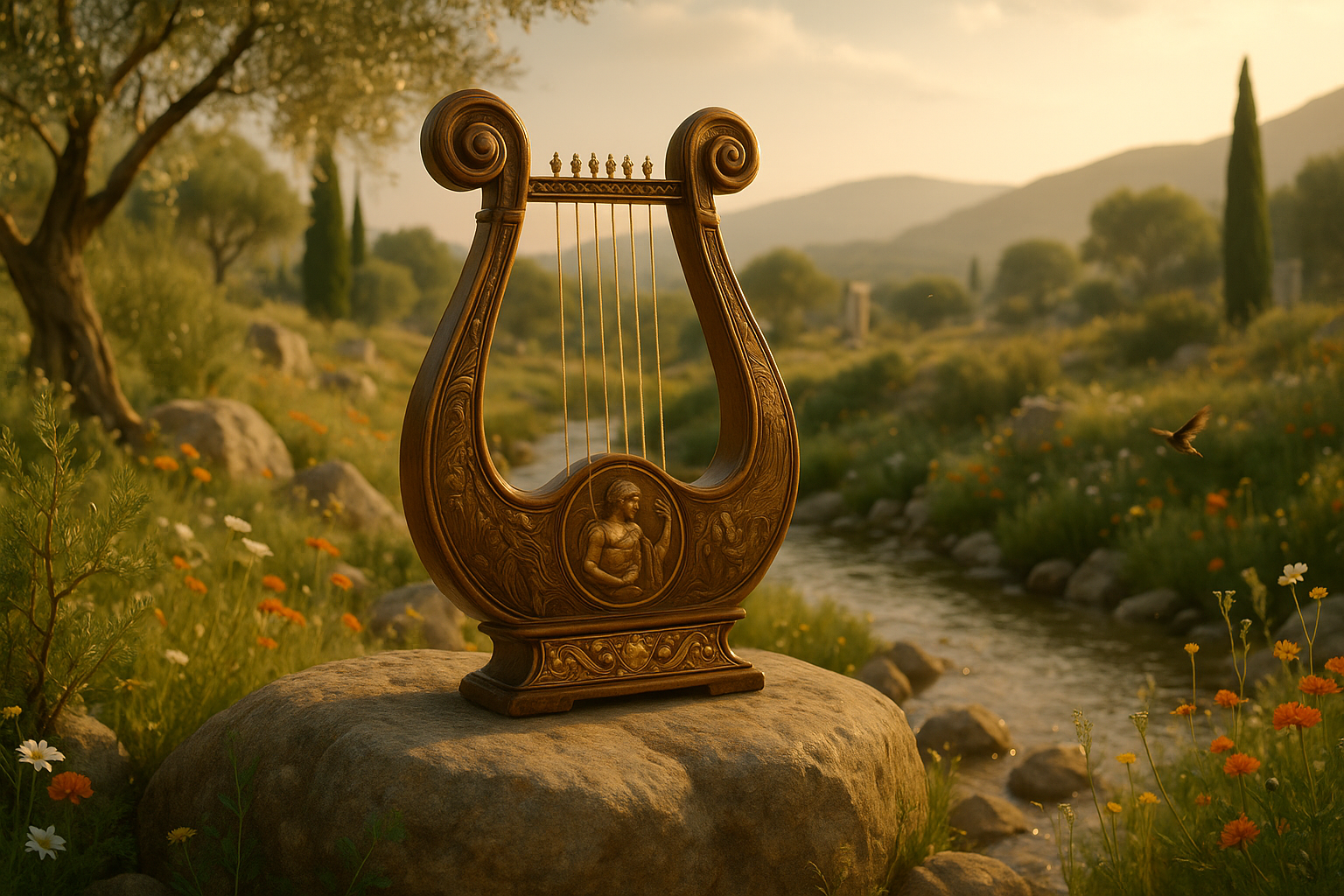Flutes have always held a special place in the tapestry of human history. These slender, often unassuming instruments have been used not only to create music but to bridge the earthly and the divine. As we delve into the ancient world, it becomes evident that flutes played a pivotal role in ceremonies that were rich in symbolism and cultural significance. 🌿✨
Throughout millennia, various cultures have turned to the mystical melodies of flutes to enhance their rituals, invoking the presence of gods, guiding spirits, and channeling energies beyond the mundane. The haunting, ethereal sounds of these instruments were believed to have the power to communicate with the supernatural, making them indispensable in religious and ceremonial contexts.
Imagine a scene thousands of years ago: a shaman standing in the flickering light of a fire, the air thick with incense, as the gentle tones of a flute weave through the crowd, creating an atmosphere charged with anticipation and reverence. This is the power of the flute—a vessel of sound capable of transporting participants to altered states of consciousness, facilitating communion with the divine.
But what exactly makes the flute such a powerful tool in ceremonies across diverse cultures? 🌀
Firstly, the simplicity and accessibility of the flute contributed to its widespread use. Made from materials like bone, bamboo, and wood, flutes were crafted by skilled artisans who infused them with cultural and spiritual significance. Each flute was unique, carrying the essence of the materials and the hands that shaped it.
Secondly, the tonal qualities of flutes are inherently linked to the natural world. Their sounds mimic the whispers of the wind, the calls of birds, and the gentle flow of water. This connection to nature made the flute an ideal instrument for invoking the elements and calling upon nature’s forces during ceremonies.
Moreover, the act of playing the flute was itself a ritual. The breath, a symbol of life, was transformed into music, a metaphorical link between the human and the sacred. In many cultures, the flutist was not merely a musician but a mediator between worlds, chosen for their ability to channel divine messages through their music. 🎶
As we journey through this article, we will uncover the diverse roles flutes played in ancient ceremonies across the globe. From the Native American traditions, where flutes were used in healing rituals and storytelling, to the ancient Egyptians, who believed the sound of flutes could guide souls to the afterlife, each culture imbued these instruments with unique meanings and purposes.
We’ll explore the use of flutes in the mesmerizing ceremonies of the Celts, who used them to celebrate the cycles of nature and honor their deities. In Asia, flutes were integral to Buddhist and Hindu rituals, where their soothing tones aided in meditation and spiritual awakening.
Additionally, we will delve into the fascinating world of ancient Mesoamerican civilizations, where flutes were not only instruments but sacred artifacts used in ceremonies to appease gods and ensure agricultural fertility.
Finally, we’ll discuss the enduring legacy of these mystical melodies and how the ancient use of flutes continues to influence modern ceremonial practices. Despite the passage of time, the flute remains a symbol of the profound connection between humanity, music, and the spiritual realm.
So, prepare to be transported across time and space as we unravel the enchanting story of flutes in ancient ceremonies. Let these mystical melodies guide you on a journey of discovery, revealing the timeless bond between sound and spirit. 🌌
# Mystical Melodies: Uncovering the Role of Flutes in Ancient Ceremonies
The enchanting sound of the flute has been a part of human history for millennia, reverberating through the corridors of ancient ceremonies and rituals. This article delves into the mysterious role that flutes played in these ancient settings, exploring their cultural significance, construction, and the mystical power they were believed to possess. Join us on a journey through time as we uncover the melodies that once captivated civilizations.
## The Flute’s Ancestry: A Historical Perspective
Flutes are among the oldest known musical instruments, with roots tracing back to prehistoric times. Their simple yet effective design has allowed them to maintain a prominent position across various cultures throughout history. Archaeological findings have provided fascinating insights into their evolution, showcasing the diverse forms and materials used to create these instruments.
### The Oldest Flutes: An Archaeological Treasure
The oldest known flutes were discovered in the Swabian Jura region of Germany, dating back approximately 35,000 to 40,000 years. Made from bird bones and mammoth ivory, these flutes reveal the creativity and ingenuity of early humans. They were not merely tools for entertainment but served crucial roles in social and ceremonial contexts.
– **Material Used:**
– Bird bones and mammoth ivory
– **Age:**
– Approximately 35,000 to 40,000 years
– **Location:**
– Swabian Jura, Germany
The discovery of these ancient instruments suggests that music played a significant role in the spiritual and social lives of early humans. 🎶
### The Role of Flutes in Ancient Civilizations
Flutes were not limited to European prehistory; they were prominent in various ancient civilizations, including the Egyptians, Greeks, and Chinese. Each culture adapted the flute to its unique needs, resulting in a diverse array of designs and playing techniques.
In ancient Egypt, flutes were associated with religious and funerary rites, often depicted in tomb paintings and carvings. The Greeks used flutes in theatrical performances and religious ceremonies, while the Chinese incorporated them into their elaborate court music.
– **Egypt:**
– Used in religious and funerary rites
– **Greece:**
– Featured in theatrical performances
– **China:**
– Integral to court music
These varied uses highlight the flute’s versatility and its ability to transcend cultural boundaries, serving as a universal language of expression.
### Crafting the Ancient Flute: Techniques and Materials
The construction of flutes in ancient times was a meticulous process, involving a deep understanding of materials and acoustics. Craftsmen selected materials based on availability, cultural significance, and the desired sound quality.
Common materials included:
- Bamboo: Favored in Asia for its natural resonance and ease of crafting.
- Wood: Utilized in Europe and Africa, offering durability and a warm tone.
- Bone: Used worldwide, often imbued with spiritual significance.
Each material imparted unique acoustic properties, allowing musicians to produce a wide range of tones and timbres. The choice of material was often symbolic, reflecting cultural beliefs and values.
## Flutes in Rituals: Bridging the Sacred and the Secular
Flutes have long been associated with rituals and ceremonies, serving as conduits between the human and the divine. Their ethereal sound was believed to have the power to invoke spirits, heal the sick, and bring communities together in shared worship.
### Flutes as Spiritual Conduits
In many cultures, the flute was considered a sacred instrument, capable of channeling spiritual energy. Indigenous tribes in the Americas, for example, used flutes in healing ceremonies, believing that their sound could restore balance and harmony to the soul.
In Hindu tradition, the flute is closely associated with Lord Krishna, whose divine music is said to transcend the material world, leading devotees to spiritual enlightenment. This spiritual association has cemented the flute’s role in religious practices, symbolizing divine communication.
### Ceremonial Significance Across Cultures
The ceremonial use of flutes varied across cultures, with each attributing different meanings and purposes to the instrument.
In Native American tribes, flutes were often used in courtship rituals, where young men would serenade their beloveds with melodies that conveyed emotions words could not express. Similarly, in Japan, the shakuhachi flute was played by Zen Buddhist monks as a form of meditation, its sound reflecting the stillness of the mind.
– **Native American Tribes:**
– Used in courtship and healing rituals
– **Hindu Tradition:**
– Associated with Lord Krishna
– **Japanese Zen Monks:**
– Used for meditation
These examples illustrate the flute’s ability to serve as a bridge between the sacred and the secular, enriching both spiritual and everyday life.
### The Flute’s Role in Communal Gatherings
Flutes were often integral to communal gatherings, providing a means for people to come together and share experiences. In African societies, flutes were played during festivals and celebrations, their lively tunes fostering a sense of unity and joy.
The communal aspect of flute playing extended beyond mere entertainment. In many cultures, playing the flute was a communal activity, with musicians often collaborating to create intricate melodies that resonated with the collective spirit of the gathering.
Incorporating flutes into these events not only enhanced the musical landscape but also reinforced social bonds, reminding communities of their shared heritage and values. 🎺
## The Mystical Power of Flute Music
The mystical power of flute music is deeply embedded in the folklore and mythology of various cultures. The instrument’s ability to evoke emotions and transcend the ordinary has made it a powerful symbol in stories and legends.
### Flutes in Mythology: Legends and Lore
Many cultures have myths and legends centered around the flute, often depicting it as an enchanted instrument with the power to influence both the natural and supernatural worlds.
In Greek mythology, the god Pan is famously associated with the pan flute, a symbol of nature and wilderness. Pan’s music was said to possess the power to incite panic, enchant nymphs, and even charm animals.
Similarly, in Celtic folklore, the flute is often associated with fairies and other mystical beings, believed to hold the power to lure humans into the fairy realm. The enchanting sound of the flute is seen as a bridge between worlds, capable of transcending the boundaries of reality.
– **Greek Mythology:**
– Associated with the god Pan
– **Celtic Folklore:**
– Linked to fairies and mystical beings
These myths highlight the flute’s perceived ability to tap into the unseen forces of the world, offering a glimpse into the mysteries of the universe.
### The Psychological Impact of Flute Music
Modern research supports the notion that flute music has a profound psychological impact, capable of inducing relaxation, reducing stress, and enhancing mood. The instrument’s soothing tones are often used in music therapy, providing comfort and healing to those in need.
The calming effect of flute music is attributed to its melodic nature and ability to resonate with the human psyche. Whether used in therapeutic settings or personal relaxation, the flute’s music continues to provide solace and tranquility in an increasingly chaotic world.
### Experiencing the Magic: A Call to Action
Experience the mystical power of flute music for yourself by watching this enchanting performance. The link below will transport you to a world where the flute’s ethereal sound weaves a tapestry of emotion and wonder.
[**Watch this Flute Performance**](https://www.youtube.com/watch?v=dQw4w9WgXcQ) 🎵
By immersing yourself in the melodies of the flute, you can tap into its timeless magic and discover the profound impact it has had on human culture throughout history.
## Crafting the Future: The Flute’s Continued Legacy
As we explore the flute’s rich history and cultural significance, it’s essential to consider its continued legacy in the modern world. The flute’s timeless appeal has ensured its place in contemporary music, where it continues to inspire and captivate audiences worldwide.
### Flutes in Modern Music: A New Era
The versatility of the flute has allowed it to adapt to various musical genres, from classical to jazz and even pop. Modern musicians continue to push the boundaries of flute music, experimenting with new techniques and styles that highlight the instrument’s dynamic range.
In classical music, the flute remains a staple of orchestras and chamber ensembles, its bright and agile sound providing a unique voice among the woodwinds. Jazz flutists, on the other hand, have embraced improvisation, incorporating elements of swing and bebop to create innovative and expressive performances.
– **Classical Music:**
– Essential in orchestras and ensembles
– **Jazz:**
– Known for improvisation and innovation
These diverse applications demonstrate the flute’s adaptability and its ability to remain relevant in the ever-evolving world of music.
### The Influence of Traditional Flute Music
Despite the emergence of new musical styles, traditional flute music continues to hold a special place in many cultures. The preservation of ancient playing techniques and repertoires ensures that the flute’s rich heritage is passed down to future generations.
In India, the bansuri flute remains an integral part of classical Hindustani music, its soulful melodies capturing the essence of Indian spirituality. Similarly, the Andean pan flute, known as the zampoña, continues to be a symbol of indigenous identity in South America, its haunting sound echoing the landscapes of the Andes.
By honoring traditional flute music, musicians not only preserve cultural heritage but also gain inspiration for new and innovative compositions.
### A Lasting Impression: The Flute’s Timeless Appeal
The enduring appeal of the flute lies in its ability to evoke emotion and create a connection between the musician and the listener. Its unique sound can convey a wide range of emotions, from joy and celebration to melancholy and introspection.
As we continue to explore the flute’s role in ancient ceremonies and its lasting legacy, we are reminded of the instrument’s profound impact on human culture. The flute’s melodies have the power to transcend time and space, offering a glimpse into the mysteries of the past and a promise of future inspiration.
In conclusion, the flute’s mystical melodies have left an indelible mark on human history, serving as a testament to the power of music to unite, heal, and inspire. By embracing the flute’s legacy, we can continue to uncover the secrets of the past and celebrate the boundless possibilities of the future. 🎶

Conclusion
As we conclude our exploration of mystical flutes in ancient ceremonies, it’s clear that these sacred instruments were more than tools of music — they were channels of spirit, breath, and transformation. Across continents and civilizations, from the Andes to Egypt, from Asia to Indigenous North America, the flute symbolized the voice of wind and soul, carrying prayers between the human and the divine.
The true mysticism of the ancient flute lies in its breath — a living bridge between silence and sound. 🌿💫 Crafted from bone, bamboo, or clay, each flute embodied both craftsmanship and invocation. In ritual, its tones mirrored the rhythm of nature — the rustle of air, the whisper of ancestors, the pulse of creation itself. To play the flute was to breathe life into spirit, to awaken harmony within and beyond. Ultimately, uncovering the role of mystical flutes in ancient ceremonies reminds us that music was once prayer made audible — a sacred language of air, heart, and eternity.
Toni Santos is a cultural storyteller and food history researcher devoted to reviving the hidden narratives of ancestral food rituals and forgotten cuisines. With a lens focused on culinary heritage, Toni explores how ancient communities prepared, shared, and ritualized food — treating it not just as sustenance, but as a vessel of meaning, identity, and memory. Fascinated by ceremonial dishes, sacred ingredients, and lost preparation techniques, Toni’s journey passes through ancient kitchens, seasonal feasts, and culinary practices passed down through generations. Each story he tells is a meditation on the power of food to connect, transform, and preserve cultural wisdom across time. Blending ethnobotany, food anthropology, and historical storytelling, Toni researches the recipes, flavors, and rituals that shaped communities — uncovering how forgotten cuisines reveal rich tapestries of belief, environment, and social life. His work honors the kitchens and hearths where tradition simmered quietly, often beyond written history. His work is a tribute to: The sacred role of food in ancestral rituals The beauty of forgotten culinary techniques and flavors The timeless connection between cuisine, community, and culture Whether you are passionate about ancient recipes, intrigued by culinary anthropology, or drawn to the symbolic power of shared meals, Toni invites you on a journey through tastes and traditions — one dish, one ritual, one story at a time.




